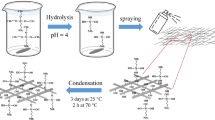Abstract
This paper investigates the effect of surface treatment for glass fiber, stainless steel wire mesh on tensile, flexural, inter-laminar shear and impact properties of glass fiber/stainless steel wire mesh reinforced epoxy hybrid composites. The glass fiber fabric is surface treated either by 1 N solution of sulfuric acid or 1 N solution of sodium hydroxide. The stainless steel wire mesh is also surface treated by either electro dissolution or sand blasting. The hybrid composites are fabricated using epoxy resin reinforced with glass fiber and fine stainless steel wire mesh by hand lay-up technique at room temperature. The hybrid composite consisting of acid treated glass fiber and sand blasted stainless steel wire mesh exhibits a good combination of tensile, flexural, inter-laminar shear and impact behavior in comparison with the composites made without any surface treatment. The fine morphological modifications made on the surface of the glass fiber and stainless steel wire mesh enhances the bonding between the resin and reinforcement which inturn improved the tensile, flexural, inter- laminar shear and impact properties.
Similar content being viewed by others
References
F. T. Wallenberger, J. C. Watson and H. Li, ASM hand book, composites, ASM International, 21 (2001) 28–34.
A. K. Kaw, Mechanics of composite materials, Second Ed., CRC Press, Taylor & Francis Group, London, New York (2006).
R. F. Gibson, Principles of composite material and mechanics, Second Ed., CRC Press, Taylor & Francis Group, London, New York (2010).
A. I. Selmy, A. R. Elsesi, N. A. Azab and M. A. A. Elbaky, In-plane shear properties of unidirectional glass fiber( U)/random glass fiber(R)/epoxy hybrid and non-hybrid composites, Composites:Part B, 43 (2012) 431–438.
M. Kanerva and O. Saarela, X-ray diffraction and fracture based analysis of residual stresses in stainless steel-epoxy interfaces with electropolishing and acid etching substrate treatments, International Journal of Adhesion & Adhesives, 39 (2012) 60–67.
O. A. Sokolova, M. Kuhn and H. Palkowski, Deep drawing properties of light weight steel/polymer/steel sandwich composites, Archives of Civil and Mechanical Engineering, 12 (2012) 105–112.
T. Takayama, Y. Daigaku, H. Ito and H. Takamori, Mechanical properties of bio-absorbable PLA/PGA fiberreinforced composites, Journal of Mechanical Science and Technology, 28 (10) (2014) 4151–4154.
H. Jung and Y. Kim, Mode I fracture toughness of carbonglass/epoxy interply hybrid composites, Journal of Mechanical Science and Technology, 29 (5) (2015) 1955–1962.
R. Senthilkumar, A. Senthilkumar and V. Ashamelba, Processing of 45 degree Stitched Mat GLARE Laminate and Analyzing Tensile and Flexural Properties, Journal of Applied Chemistry, 7 (2014) 54–62.
T. J. Ahmed, H. E. N. Bersee and A. Beukers, Low velocity impact on woven glass composites reinforced with metal mesh layers, 16th International Conference on Composite Materials, Kyoto, Japan (2007) 1–6.
K. G. Sathish, B. Siddeswarappa and K. M. Kaleemulla, Characterisation of Inplane mechanical properties of laminated hybrid composites, Journal of Minerals and Materials Characterization and Engineering, 9 (2) (2010) 105–114.
K. Pazhanivel, G. B. Bhaskar and A. Elayaperumal, Significance of stainless steel wire reinforcement on the mechanical properties of GFRP composites, International Journal of Engineering and Technology, 6 (1) (2014) 178–182.
V. Manikandan, J. T. W. Jappes, S. M. S. Kumar and P. Amuthakkannan, Investigation of the effect of surface modifications on the mechanical properties of basalt fibre reinforced polymer composites, Composites: Part B, 43 (2012) 812–818.
J. Zhang, K. Chaisombat, S. He and C. H. Wang, Hybrid composite laminates with glass/carbon woven fabrics for light weight load bearing structures, Materials and Design, 36 (2012) 75–80.
G. Goud and R. N. Rao, Mechanical and electrical performance of Roystonea regia/glass fiber reinforced epoxy hybrid composites, Bullatin of Material Science, Indian Academy of sciences, 35 (4) (2012) 595–599.
G. Rathnakar and H. K Shivanand, Fibre orientation and its influence on the flexural strength of glass fibre and Graphite fibre reinforced polymer composites, International Journal of Innovative Research in Science Engineering and Technology, 2 (3) (2013) 548–552.
G. D. Sims, W. R. Broughton, A. Kelly and C. H. Zweben, Comprehensive composite materials, Elsevier, 2 (5) (2000).
W. R. Broughton, M. J. Lodeiro and S. Maudgal, Accelerated test methods for assessing environmental degradation of composite laminates, NPL Report, MATC (A) (2000) 1–251.
A. S. Maxwell, W. R. Broughton, G. Dean and G. D. Sims, Review of accelerated ageing methods and lifetime prediction techniques for polymeric materials, National Physical Laboratory (2005) 1–84.
R. Fazel, Biomedical engineering From theory to applications, InTech publications (2011) 1–486.
Davidbcochrane, Guide to stainless steel finishes, Euro inox, 1 (2005) 1–20.
M. K. CarolLee, Hand book for abrasive blasting operations (2013).
J. L. Jones and J. Stewart, The kinetics of corrosion of eglass fibres in sulphuric acid, Journal of Non–crystalline Solids, 356 (2010) 2433–2436.
Q. Qiu and M. Kumosa, Corrosion of E-glass fibers in acidic environments, Composites science and Technology, 57 (1997) 497–507.
Author information
Authors and Affiliations
Corresponding author
Additional information
Recommended by Editor Chongdu Cho
Karunagaran N. is working as Associate professor in the Department of mechanical Engineering at S.K.P Engineering college, Tiruvannamalai, India. He has almost 12 years of teaching experience. He received his B.E. degree in Mechanical Engineering from University of Madras and M.E. degree in Manufacturing at Annamalai University, Chidambaram, India. His research interests are polymer matrix composites and optimization techniques.
Rajadurai A. is Professor in Production Technology & Dean of Madras Institute of Technology Campus, Anna University, Chennai - 44, India. He has obtained Ph.D. and M.E., Metallurgy from Indian Institute of Science, Bangalore, India. He is working as a faculty in Anna University since 1989. He has published about 50 papers in various indexed journals. His research interests are composite materials and FEA of production processes.
Rights and permissions
About this article
Cite this article
Karunagaran, N., Rajadurai, A. Effect of surface treatment on mechanical properties of glass fiber/stainless steel wire mesh reinforced epoxy hybrid composites. J Mech Sci Technol 30, 2475–2482 (2016). https://doi.org/10.1007/s12206-016-0507-9
Received:
Revised:
Accepted:
Published:
Issue Date:
DOI: https://doi.org/10.1007/s12206-016-0507-9




